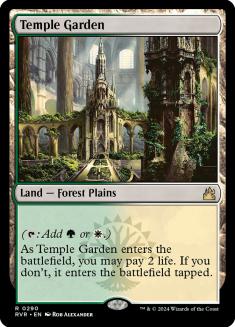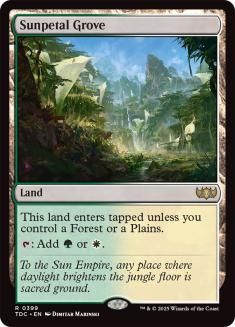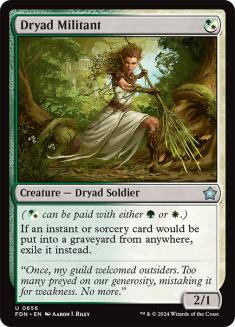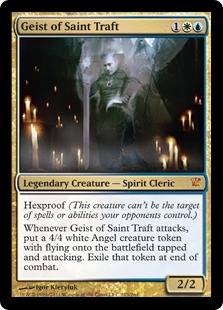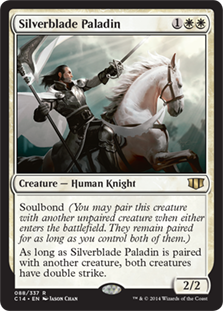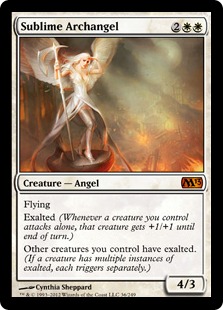We aren’t who we think we are.
Nobody has absolute self-perception. I’m forever editing how I see myself, what I can do and who I’m becoming. I’d like to think I get it right most of the time, but I know I have moments where I go wrong.
As a Magic player, I’m forever asking for advice…and considering the source when I get it. I have my own perception of others’ strengths and weakness—I’m only human—and like Sam Stoddard roommate in “A Fearless Magical Inventory” (always worth a read or a reread, wherever you are as a Magic player), I can see problems in others’ games, but the motes in their eyes are nothing like the beams in my own.
At the most recent SCG Standard Open in Dallas/Fort Worth, I played a feature match round 2 on camera against Robert Rasor. When I returned home, I watched my match in the SCGLive video archive, and what stood out to me is the difference between what I experienced and what the camera saw.
Unedited footage may not tell the whole story, but it doesn’t lie, either.
What follows is my commentary from my second time watching the archived video of my feature match. (The video is set to start at the time commentators Cedric Phillips and Joey Pasco receive my decklist and Mr. Rasor’s.) Opening it in another window so you can read and watch at the same time is recommended—that’s how I’ll write what’s to follow, in fact—though I realize this isn’t possible for some of my readers, especially on mobile.
In any case…Past self! Teach me! Entertain me!
Let’s dance.
Watch live video from SCGLive on TwitchTV
1:08:35 – That’s my decklist, preprinted on special paper with off-white color and a watermark. I think the paper was supposed to be resume paper when it was made, but by the time I found it, the days of postal mailing resumes were done, so I use it for decklists instead.
1:08:46 – Wow, Cedric actually pronounced my last name correctly! I’ve heard “Beatty” (bay-tee) and “Betty” enough times that when someone who doesn’t know me personally gets it right— (bee-tee), like the vegetable “beet” with a Y stuck on the end—it’s like a topdecked Entreat the Angels.
1:09:22 – That was a pretty good summary of my maindeck, though the sideboard also has a bit of blue with Lyev Skyknight. Here’s my full list in all its not so glory:
Creatures (37)
- 4 Champion of the Parish
- 3 Avacyn's Pilgrim
- 3 Geist of Saint Traft
- 3 Mayor of Avabruck
- 3 Thalia, Guardian of Thraben
- 4 Silverblade Paladin
- 4 Sublime Archangel
- 4 Knight of Glory
- 3 Thragtusk
- 3 Dryad Militant
- 3 Loxodon Smiter
Lands (23)
Sideboard

1:10:00 – Also a good summary of Robert’s list. In a later round, when I played Robert’s friend Matt Young, Matt was piloting the same deck (a collaboration between the two of them and Paul Whitcomb), and Vault of the Archangel was an all-star. It landed, and a game that seemed winnable suddenly went far, far out of reach. Thinking back, my aggro-stretch-midrange deck is a definite underdog against Robert’s deck. I need to be faster than him, and for the first game at least, I’ve built my deck to trade off a bit of speed for outlasting most aggressive decks.
Creatures (22)
- 2 Arbor Elf
- 2 Avacyn's Pilgrim
- 4 Restoration Angel
- 4 Thragtusk
- 4 Disciple of Bolas
- 3 Loxodon Smiter
- 1 Angel of Serenity
- 2 Armada Wurm
Planeswalkers (3)
Lands (25)
Spells (10)
Sideboard

1:10:06 – Hallelujah? No, just the die roll. The [author name="StarCityGames.com"]StarCityGames.com[/author] hooded sweatshirt and red “Project Mercury” tie (Cyberoptix, my designer of choice) make for a slightly different “jacket-and-tie” combination than sometimes seen in the arena where we are playing. Religious gatherings are common in the arena part of the convention center, which also has played host to the Davis Cup, at least one mixed martial arts event that I know of, and the odd lower-level hockey team.
1:10:12 – I…need a haircut. I would not meet the Mesquite Independent School District’s dress code. Then again, the Mesquite ISD is crazy-strict by U.S. public school standards: on a male, anything touching the collar doesn’t meet the dress code. There are no exceptions.
1:10:30 – I am in fact on the play, and the die roll is just what the doctor ordered.
1:11:40 – First mulligan. I have five lands and two spells: a Dryad Militant and a Sublime Archangel. On the plus side, I’m able to cast anything in my deck. On the other hand, I have no second-turn or third-turn plays, and let’s face it, Sublime Archangel isn’t that impressive if it’s alone on the battlefield. Against an unknown deck, I could get run over or my Dryad Militant eliminated, and then where am I? I send it back.
1:12:20 – My bald spot is huge. Also, as for what I’m looking at: the judge and the coverage team communicate via laptop, and because of the setup in use at this tournament, the judge had to sit beside one of us. I was on the laptop side, so I could see the communication back and forth (usually life totals, Cavern of Souls creature types, and so on—never any strategic information). At the time, one or the other of the coverage blokes had just described the Scrabble tiles I had (off camera) as “eccentric.”
Quirky though they may be, the pairs of Scrabble tiles serve two important functions: marking soulbond (A matches A) and Cavern of Souls. I had a piece of cardboard (at the top right corner of the play surface screen) that listed five relevant creature types: Angel, Beast, Cleric, Human, and Soldier. Drop a Scrabble token on the Cavern of Souls and another in the proper place on the card (B matches B) and presto, instant visual confirmation! Of course, I didn’t realize that the cardboard creature type boxes, while fine for over-the-table play, were useless for the overhead camera because it’s zoomed out so far.
1:12:45 – Second mulligan, going down to five. I have one land, a Temple Garden, and a pair of one-drops, Dryad Militant and Champion of the Parish, but everything else costs three or more and there’s a Geist of Saint Traft in the mix. This deck hates going to five cards, but it hates being land starved even worse. Back it goes.
Rewind a little and watch my facial expressions as I’m examining my six-card hand. I’m clearly not happy with it, and the amount of time I’m taking suggests I have a hard decision on my hands. That’s information I would’ve been leaking had I kept the hand. I have to work on that.
1:14:35 – I keep a hand with Knight of Glory, Silverblade Paladin, Sunpetal Grove, Plains, and Glacial Fortress. As five-card hands go, it’s near optimal. I’m still not happy being on five, but it’s a quality five. On the other side of the table, I’ve Temple Garden, Vault of the Archangel, and now Overgrown Tomb. The Vault of the Archangel is giving me a pretty good clue that I’m not facing a Reanimator-style Junk deck but rather a creature-oriented one. That means bodies on the board getting in my way. I need to push through damage sooner rather than later.
1:18:20 – Mr. Rasor missed his land drop and had only a Loxodon Smiter to try to stem the bleeding from my two-card assault. Mr. Rasor notes (this and future notes by e-mail, lightly edited for SCG style) for this game: “I had two lands, Farseek, Farseek, Garruk, Primal Hunter, Restoration Angel, and a Sever the Bloodline. I figured I would run into a land in the next three turns. I didn’t expect you to come out of the gates like you did after mulliganing to five.”
1:19:00 – Mr. Rasor, having stumbled badly on his mana, packs it in. He could’ve passed on an empty board and launched a surprise Restoration Angel, but with the correct attack (all three creatures), I’d still deal four damage with either of the soulbonded creatures and a minimum of two from the un-bonded Knight of Glory, so I had lethality. As the commenters mentioned, it was perhaps a bit soon to concede the game, but in the end it would have made little difference. Mr. Rasor notes: “You ran over me and only saw two cards, so I conceded early so you wouldn’t know what my game plan was.”
1:20:45 – Cedric talks about my sideboard. My operations are suboptimal here: if Mr. Rasor is observing closely, he knows exactly how many cards I’m substituting. The canonical “safe” sideboarding strategy is to shuffle in the sideboard and remove fifteen cards, but I have difficulty doing that in a timely fashion. I need to spend time doing “sideboarding drills” where I practice the fifteen in, fifteen out form. It’s one more way to improve my game.
Here’s how I actually sideboarded:
-3 Mayor of Avabruck
-3 Thragtusk
+3 Lyev Skyknight
+3 Selesnya Charm
I consider removing Thragtusk correct, as in this matchup I’m the aggressor. If I’m casting a Thragtusk in the absence of an Avacyn’s Pilgrim, much less swinging with it, chances are I’ve lost the game. Removing the Mayor, however, is a colossal mistake. Cedric is absolutely correct that Thalia needs to come out.
My rationale at the time was that I saw a lot of spells and not much in the way of creatures, though Vault of the Archangel should’ve tipped me off that he was planning on casting a lot of creatures. Thalia is a disruptive card, but what am I seeking to disrupt? Farseek? I’m on the draw. I won’t be disrupting a second-turn Farseek. Mayor of Avabruck, on the other hand, gives me a chance at extra damage and a steady stream of attackers and blockers if the Mayor ever flips to Howlpack Alpha.
Mr. Rasor’s sideboarding:
“-2 Armada Wurm
-2 Cloudshift
-1 Angel of Serenity
-1 Disciple of Bolas
-1 Garruk, Primal Hunter
+4 Centaur Healer
+2 Abrupt Decay
+1 Sever the Bloodline “
1:23:00 – I don’t remember this conversation at all, and I’m bad at reading lips. When I’m chatterboxing like this, I’m nervous. I didn’t realize I make all of those hand gestures between games. I’ll have to cut down on that.
1:25:00 – It’s right around here that I realize that on camera, I look like a pasty schlub. Beyond the haircut, I need to lose more weight. I also realize neither commenter has noted that I write for StarCityGames.com. I thought everybody knew me! (In all seriousness, in terms of Magic celebrity, I’m on the D-list at best. I’ve only once been recognized outside a Magic event as a Magic writer by a complete stranger, at my local Smashburger.)
1:26:00 – Both of us have aggressive ramping starts with a first-turn mana booster and a second-turn Loxodon Smiter. As the first player, however, Mr. Rasor has the tempo advantage, and he’s going to press it.
1:27:00 – The precombat Centaur Healer on Mr. Rasor’s end might be better suited for postcombat. As it stands, Mr. Rasor now can access only one (green or white) mana through Arbor Elf untapping Temple Garden. I have a lot fewer tricks to fear in the upcoming combat phase when he attacks with Loxodon Smiter and invites a trade.
Mr. Rasor writes: “I played the Centaur Healer because I wanted you to see that I had no tricks so you would trade Smiters with me. You didn’t take the bait, and I had to cringe as you played a Paladin.” I don’t necessarily agree with the line of play, but I see where he’s coming from.
1:29:00 – I can trade off the Silverblade Paladin, but then my clock becomes far longer. Whatever I do, I cannot afford to shorten my clock. I have to race.
Shortly after this time, note how Cedric states that he can’t see my hand well but there’s fairly accurate reporting on Mr. Rasor’s hand. I prefer to keep my hand either straight up-and-down or tilted just a touch toward me to minimize the possibility of leaking information about my hand. With a tilt toward me, even a dropped card will tend to fall facedown.
1:29:20 – My relationship with Disciple of Bolas prior to this match: I played it in Magic 2013 once and didn’t like it. Nowadays, we have something more like cordial loathing. So he gets to sacrifice a Loxodon Smiter, draw four cards, and gain four life, all while sitting on a 25-11 life total advantage at the end of it all? Yeah, that’s some good. On the other hand, he’s setting himself up for some potential short-turn hurt…
1:31:20 – … And here it comes. After Stupid Selesnya Charm Tricks, my double-striking Loxodon Smiter is a 6/6 double-striking trampler blocked by a 2/1. Eleven trample damage from the Smiter plus four from the Paladin yielded a stomach-turning life total drop from 25 to 10. Suddenly, Mr. Rasor is down on life and on the board. He has cards in hand, but will they be the difference?
Unbeknownst to me, Mr. Rasor had drawn beautifully from the Disciple of Bolas: “Resto[ration Angel] and Thragtusk.” This is about to get ugly.
1:33:50 – Mr. Rasor’s Sever the Bloodline takes my Silverblade Paladin offline, and an Avacyn’s Pilgrim adds to the blockers. But when Avacyn’s Pilgrim is assigned to block Loxodon Smiter (given +1/+1 by a newly cast Knight of Glory’s Exalted trigger) alone, Stupid Selesnya Charm Tricks 2 gives Mr. Rasor sequel-itis and drops him down to four life.
1:35:10 – The precombat Thalia, Guardian of Thraben is to try to force any Cloudshift shenanigans with Thragtusk to happen before I commit to an attack. (I don’t even know at this point if Mr. Rasor has Cloudshift in his deck or that he sideboarded them out, but Cloudshift is a reasonable card to play around.) Of course, with Mr. Rasor back up to nine life, I’m not thrilled with where I am anyway. It’s starting to show in my body language. Add another entry to the Fearless Magical Inventory.
1:35:40 – The double block is because Mr. Rasor has topdecked another Thragtusk. A single block creates the possibility of Stupid Selesnya Charm Tricks 3, plunging him down to five life and leaving him vulnerable to a topdeck of Sublime Archangel or a similar card. As is soon observed, the Selesnya Charm should cost three mana; spectators point out the mistake around the same time the commenters in the booth not it, and we fix the board. Another for the Fearless Magical Inventory: I cast Thalia that turn and forgot that it affected my own noncreature spells too. If I didn’t have the fifth land, that would’ve been a devastating game rules violation.
1:36:30 – The commentators talk about how Selesnya Charm is beautiful for me, and if the topdecked Thragtusk had been, say, a land instead, it would indeed have been marvelous. In an odd way, though, my Selesnya Charm frees Mr. Rasor from his big worry: “I saw the Glacial Fortress and was thinking Essence Scatter. My mind has been trained to do that when playing Thragtusk.” Had I recognized Mr. Rasor’s fear, I could’ve played on it, but I hadn’t even thought of Essence Scatter as a sideboard card, much less one he might fear out of my sideboard. The information was out there, but I didn’t use it.
1:37:15 – Body language alert! I draw a Lyev Skyknight off the top and completely change positions. I’m leaning forward, studying the board, turning the wheels in my mind. It’s obvious I have something, and while I can’t have too many secrets in a topdecking situation, at the same time, I need to be careful about such things.
1:38:40 – Mr. Rasor explains the main phase Restoration Angel: “I didn’t want to chance you topdecking a counterspell.”
1:40:00 – Another instance of body language, blatant enough that the commenters are reading me totally. I thought I was better than this. Self-deception can be a powerful force, but the unedited camera is stronger. I can’t lie. This is humbling.
1:40:30 – By this time, I figure myself for dead, even having drawn the second Lyev Skyknight, but I still leave myself hope. I know that Sever the Bloodline is in Mr. Rasor’s graveyard, and because of his last turn’s Farseek, I know he can pay the flashback cost plus the Thalia tax. If he remembers it, I’m toast, so I have to play as if he will not remember it. I attack Mr. Rasor, putting him to ten—those four points of life could be huge if he neglects his Sever the Bloodline—and pass the turn.
The gambit works and doesn’t work. From Mr. Rasor: “You later told me that you were trying not to make eye contact with my graveyard so I wouldn’t remember and that actually threw me off. When you played the Skyknight I was thinking, ‘Ok, I have Sever. Do I have Sever?? Or was that the last game??’ [JDB’s note: It was both.] So I double-checked. If you would have played a Sublime Archangel, my jaw would have dropped.”
1:41:00 – Alas, Saints and Angels are not showing this match, and I scoop it up.
1:41:25 – I’m shuffling right now, and I don’t go back to my sideboard. In retrospect, I should’ve known by this point that Thalia isn’t where I want to be and Mayor is. On the other hand, when I’m on the play, Thalia can stop a Farseek hand in its tracks. On the balance, I’m calling it for Mayor, but I’m curious what others think.
On a more general level, not going back to the sideboard, even if I’m not swapping out any cards, is something of a mistake. It’s another chance to prey upon Mr. Rasor’s fear of Essence Scatter—a fear I never even considered.
1:42:35 – It’s interesting that Dryad Militant is fingered as a card to take out in the commentary. It’s a first-turn attack for two, and I need an aggressive start.
1:43:00 – Two games gone and still no mention of my writing. It’s meme time.
1:43:30 – I remember what the conversation is here: Breaking Bad. I’m adjusting my tie “Gustavo Fring style,” thereby invoking the Irony Fairy and inviting her to smack me around a little. (Spoiler alert.)
1:43:45 – What. Am. I. Doing.
1:44:20 – The biggest decision of the match, and I’m still not sure if I blew it. Here’s the hand as best I can reconstruct it:
I’m on the play. My remaining mana sources are 21 lands, twelve of which can generate blue mana to cast Geist of Saint Traft, and three copies of Avacyn’s Pilgrim. I didn’t have Dan Nelson Limiting Chance article on two-land hands at my fingertips in the moment, but using a bit of my probability course in college, I calculate my odds of missing my third land-drop at roughly two in seven. (The actual irreducible fraction is 203/689, for a roughly 29.46% chance of being stuck on two mana, versus the 28.57% chance I calculated in the moment.) Bump it up a little and call it 70/30: 70% that I wind up with a hand that can take the fight to Mr. Rasor and attack him until the Fort Worth Stockyards do their next cattle drive against a 30% chance that I’m going to have an irredeemably miserable deciding game.
I’m weighing whether to keep the 70/30 or gamble on a six-card hand—basically begging for “Champion of the Parish, Knight of Glory, Silverblade Paladin, and three lands that produce white mana,” a tall order—when I catch something in the look on Mr. Rasor’s face when he picks up his hand: he didn’t like what he saw. I say I’m keeping.
This is an operations issue for both of us: looking at our hands before we’re required. Without meaning to, Mr. Rasor gave away a bit of information that betrayed weakness and cemented my decision; if he stumbles, that gives me more chances to draw out of my land shy predicament.
1:44:42 – Mr. Rasor has spent a good long time looking at his hand, and his discomfort with it is plain. I offer a bit of unsolicited advice: “If you have to think about it that long, throw it back.” He thinks about it some more, grins a little, gives it a bit more thought, and keeps. Off we go!
1:45:20 – My draw is Selesnya Charm, a card with converted mana cost two but not itself a two-drop. It also is not a mana source, which gives me a bit of a jolt. Now I have a 46% chance of drawing the land I need, and it’s better than 50/50 that I’m in for a rough few minutes.
1:45:50 – I draw a Lyev Skyknight, and I don’t hide my reaction well. The commenters wonder what sort of hand Mr. Rasor kept to not have any first- or second-turn plays. Mr. Rasor: “Game 3, I was having a hard time deciding to keep or not. This game is pivotal so it was a winning or losing decision to make. I decided to keep because I had the mana I needed and had two strong three-drops. I figured that if I weathered the storm early then I might be able to stabilize later.”
1:46:00 – After I make my attack, I say, “And I’m busted. Go.” Mr. Rasor responds, “I’m sorry, man,” and all I can do is shrug and say, “It’s Magic.”
1:46:30 – My draw clearly is not a land based on how I don’t windmill-slam it on the table. The Champion of the Parish I topdeck would’ve been nice in my opening hand, but maybe it’ll be the start of something good?
1:48:00 – Operations error: I put the Selesnya Charm that I cast on a Dryad Militant in my graveyard. Smooth move. As for the one-for-two trade, maybe Mr. Rasor hasn’t improved his hand and is mana flooded where I’m suffering from mana screw. A blue-producing land would let me chain Lyev Skyknight into a Silverblade Paladin and maybe I could get something going…
1:48:20 – No such luck. Shiny doom comes down in the form of a foil Garruk, Primal Hunter—a card I hadn’t seen before in the match and which I had to read. When I got to the second ability, a Bible verse came to mind, Mark 11:15. It’s one of several in the New Testament that mentions Jesus flipping tables. (I wouldn’t actually flip a table at a Magic tournament, nor would I condone anyone doing so. Back to regularly scheduled programming.)
1:48:40 – The Irony Fairy looks a lot like Xzibit.
1:49:30 – This was a double check to make sure my opponent could draw three cards based on the battlefield, even if I did a one-for-two trade. Oh, you cast a Thragtusk? I kind of expected that the way this game was going. Draw five cards? Sure, knock yourself out. The board state looks like total piling on, but Mr. Rasor was just playing good solid Magic. When you have a chance to shut the door, slam it.
1:50:30 – At first it looks from above as if I drew yet another spell, but in truth I found a third land, a Cavern of Souls. It takes me some time to settle on what the best possible play is. I eliminated Geist of Saint Traft early on, so Cavern of Souls came down naming Human. Then the question became Lyev Skyknight or Silverblade Paladin. Skyknight stops a creature from attacking for a turn, but I’ll still lose most of my board on the next attack in the best case. With a 3/3 Champion of the Parish boasting double strike, on the other hand, I might have a chance to stop the mauling for a turn. Down came a Silverblade Paladin, there were fiddly things with counters, and I had just a little shred of hope…
1:51:55 – … But what does Mr. Rasor draw for the turn? Sever the Bloodline. (He admitted during de-sideboarding that the Sever was a topdeck.) Our conversation goes as follows:
Him: “Sever the Bloodline?”
Me: “Targeting?”
Him: “Champion of the Parish.”
Me (pointing): “Drop the card.”
Him (doing so): “?”
Me (stealth concession handshake): “You got it!”
1:52:15 – Looking at my face, I did a decent job keeping frustration off it. No, it wasn’t fun losing to a lack of land in my topdecks, but I didn’t pull a McKayla or anything. Cedric and Joey gave their “stumbling on mana is a disaster” commentary with the camera on them, while back at the table Mr. Rasor apologized again for how the third game played out and I reminded him of the first game, where he was the one to stumble on mana.
Mr. Rasor and I left on good, friendly terms, as evidenced by his generously contributed thoughts and notes here. I’m happy to say thanks and give him a tip of the hat for making this article far richer and more three-dimensional than it would’ve been otherwise.
***
Not everybody is lucky enough to get a feature match on camera with archival footage from multiple cameras, but recording oneself during play can pay dividends for you as well. Even a cellphone camera of sufficient resolution set to record a game of Magic can give you clues as to your good points and bad habits to purge. I’ve added six “items to improve” to my Fearless Magical Inventory after watching the video of my match:
- Body language (leaning forward or back in my chair)
- Facial expressions (smiles and frowns)
- Game rules (remembering effects of Thalia and Dryad Militant)
- Tournament operations (the shuffle in sideboard plan)
- Mulliganing (the 70/30 decision to start the third game)
- Combat (when and when not to trade)
I hope my mistakes have helped you learn and, more importantly, that they set you on a path to explore and refine your own Magic play skills.
As always, thanks for reading.
— JDB
@jdbeety on Twitter

